Smart home: protection against water leaks, the system Aquastorozh
I already wrote about the components of a smart home - the lighting control system . A smart home, like any robot, must obey the three laws of robotics , the third of which says: a robot must take care of its security to the extent that it does not contradict the First and Second Laws. Those. One of the tasks of a smart home is to take care of its safety, not to allow burglary, fire, flooding, and other damage. We will talk about protection from leakage and flooding today.
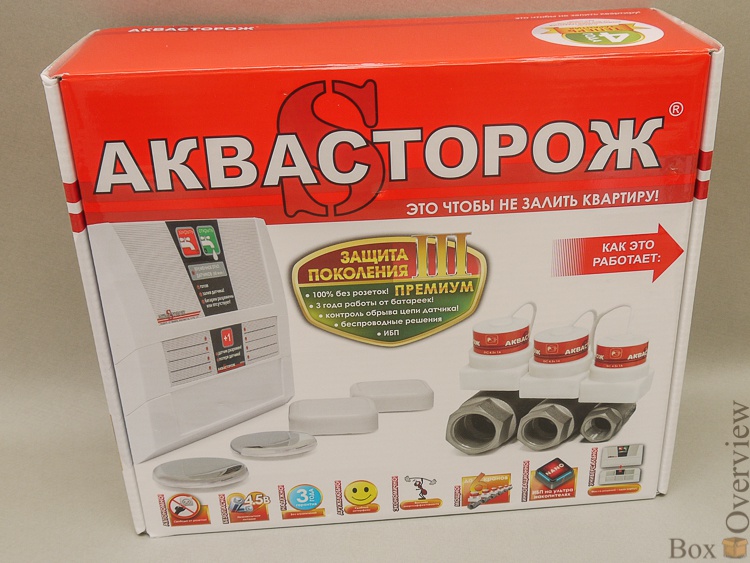
Aquastoroz is a system that automatically shuts off water when flooding is detected. A pipe burst through - water gushes on the floor, hits the sensor, and the servo closes the taps on the risers. Of course, it will not save you from wet floors - some of the water will still be on the floor, but the repair will protect, and at the same time protect you from compensation after the flooding of your neighbors below. Let's see, we will disassemble the Aquastoroz system into parts and find out if it is so good?
Controller
The whole set is in this box:

The front shows the kit, and on the side, the principle of the system:
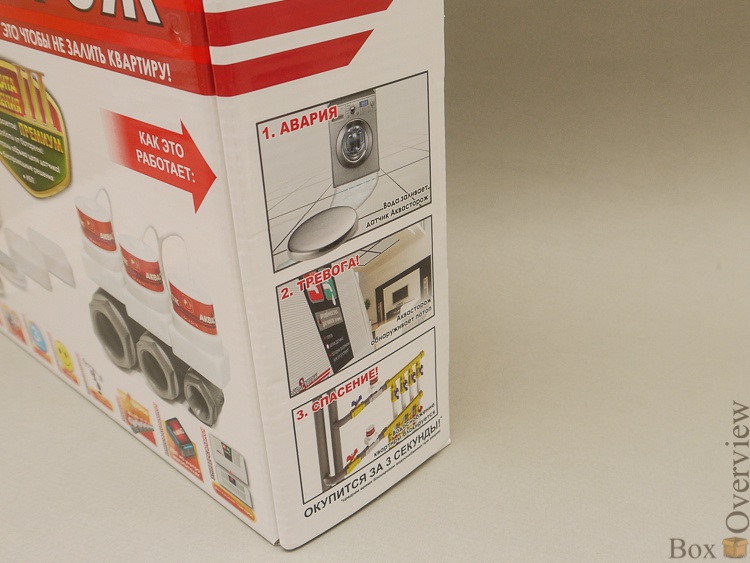
There is also a good and clearly written user manual:
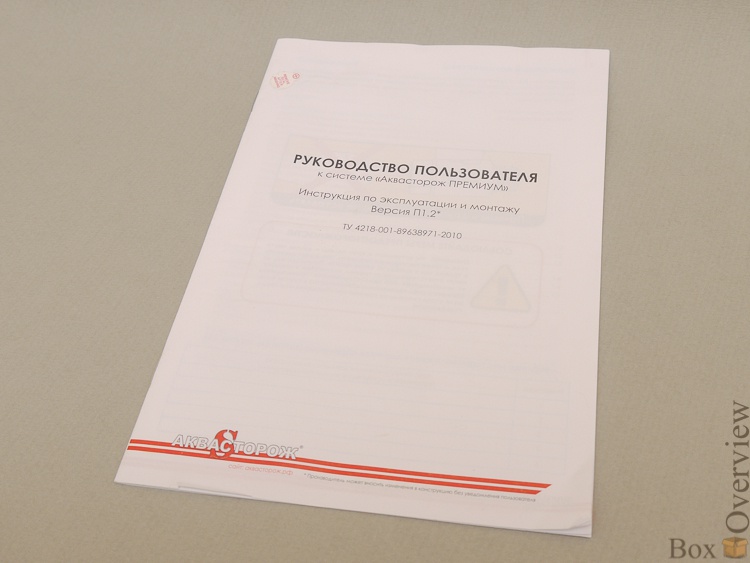
The main part of the system looks like this:
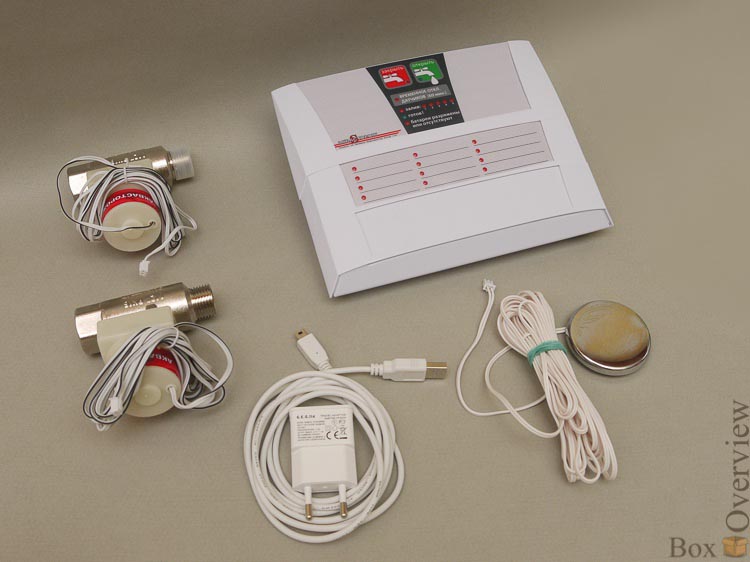
Two taps - for cold and hot water, the main control unit, bay sensors, an external power supply.
Here is the main unit (TK03) closer:
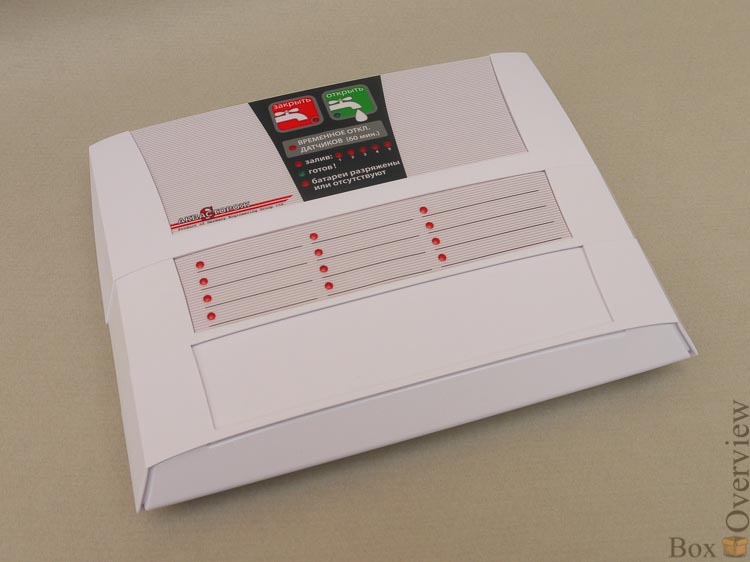
The controller is made very interesting - it is going as a constructor into which additional blocks of extensions are inserted. Not enough 6 wired sensors? Add a panel, we get 18 sensors. We want to make a wireless system out of a normal system? Insert the radio base and connect it to a special plug. Need the ability to turn off the heat or the pump when the water is turned off? We connect the panel with power relyushki. Not enough standard battery pack? We insert one more, extend the autonomous operation of the system for another year (if there are only wired sensors in the system, then for three years).
The entire system, except for wired sensors, is valid for 4 years. On the sensors lifetime warranty. True, they promise a free replacement of no more than 3 sensors per user, apparently guided by the consideration “if a person breaks 3 sensors in a row, then the problem is not with the sensors”.
In my version of the sensors, four - two wired, and two radio sensors. The system can simultaneously work with those and with others. The maximum number of wireless sensors is 8 (2 included), or 20 with an expander panel (TK19). The number of wired sensors is almost unlimited - in each connector you can connect a chain of up to 100 pieces, in total - as many as 600 pieces.
The site has a page on which all possible components with articles are described - in the future I will quote them in brackets for convenience.
Very interesting solution. Here is the mechanism for connecting the blocks, on one side of the latch:
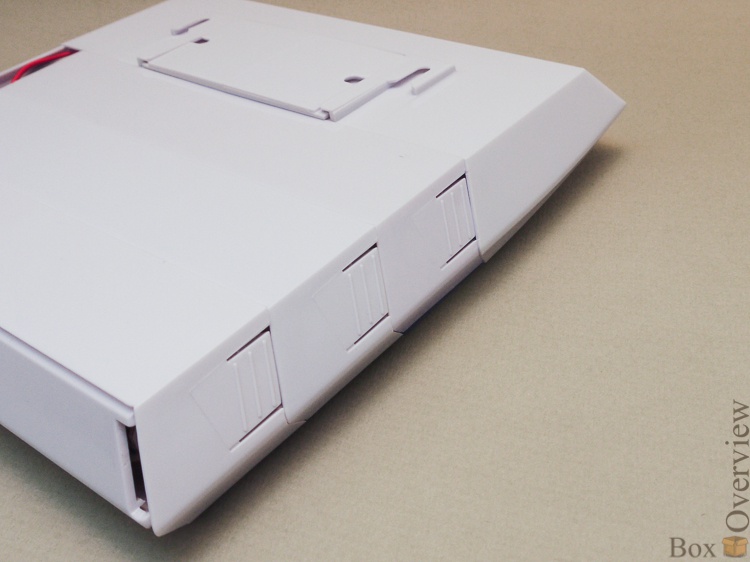
On the other - a place for wires that connect the blocks to each other:

We understand. Although disassembly is difficult to call - just pull the board out of the slots:
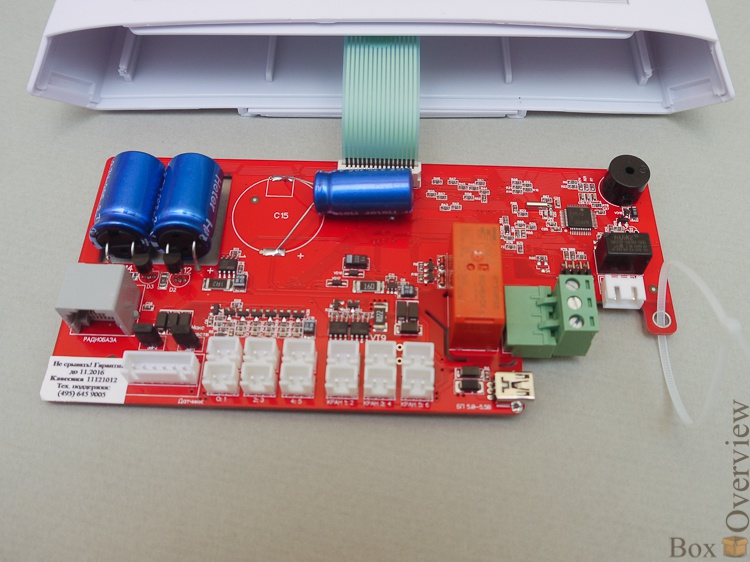
Controller, beeper (very loud and nasty):
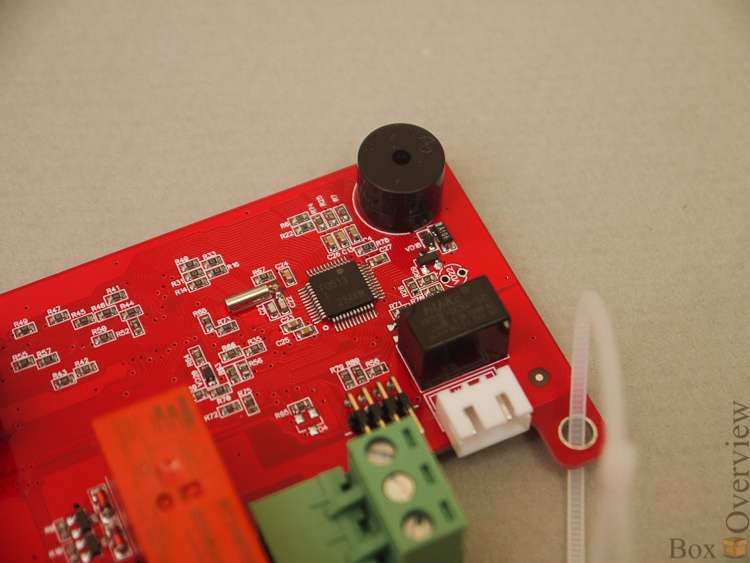
Two ionistors on 20F:
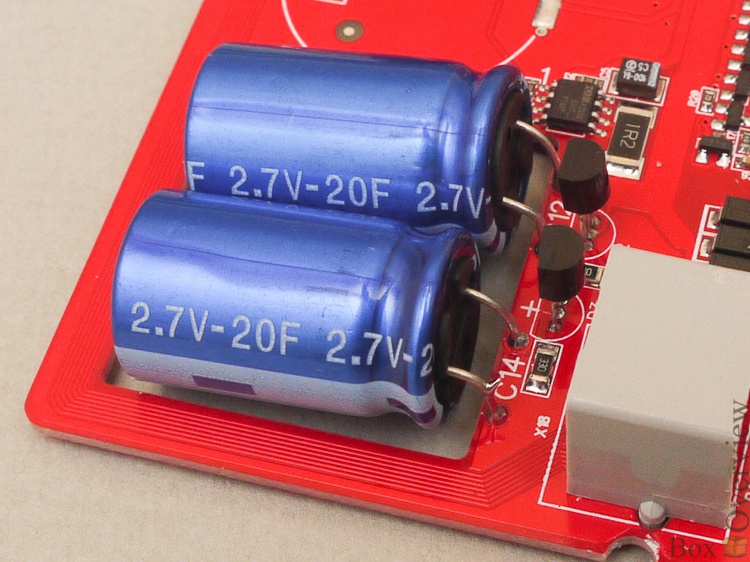
And one on 10:

These are the same Nano-UPS :)
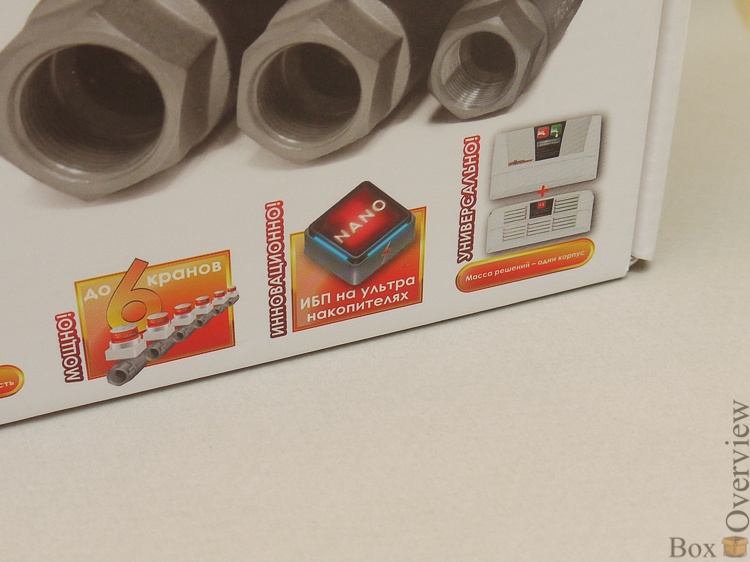
But as a matter of fact, it is correct - they store a store of energy, which is enough for the device to work and the cranes to shut off after the batteries have completely sat down. In general, if an accident occurs, the system will work and shut off the water even when batteries are dead. After that, you can still once open the taps with a button, if you urgently need water, and there is no time to run after the batteries - this moment is thought out, which is nice. But after that, the battery will have to be replaced.
Below on the board are 14 connectors, one of which is for the battery pack, one for connecting blocks, 6 for wired sensors, and 6 for taps. As I already wrote - wired sensors can be almost unlimited number - they can be connected in parallel with each other. However, when using a sensor with a break control, it must be the last in the chain - otherwise the controller will not notice a break after it.
Cranes
Here are two cranes (TK12):
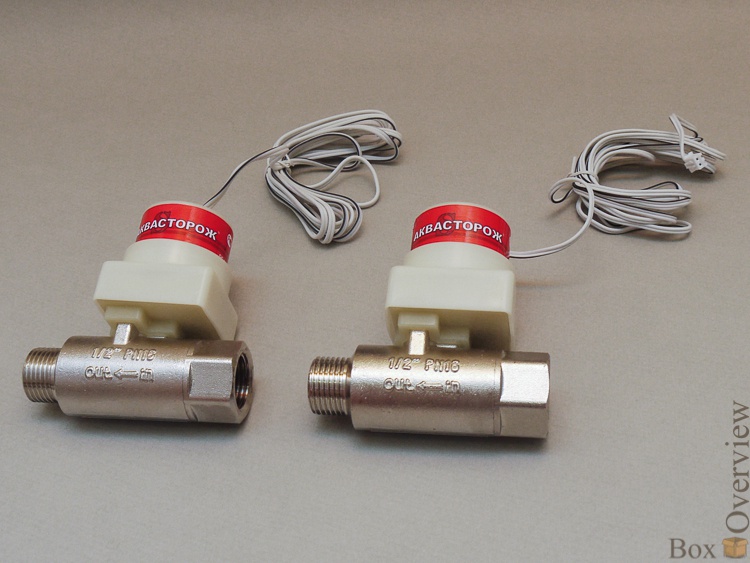
On each - a strict piece of paper :)
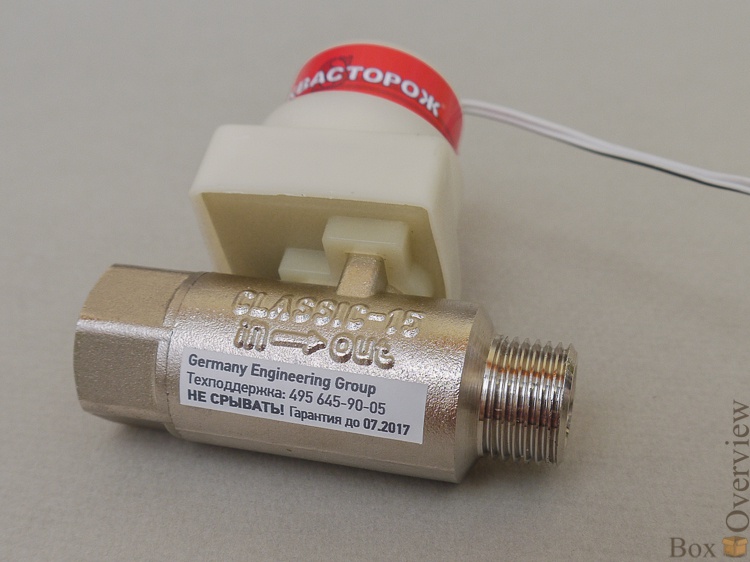
We disassemble the crane into two parts:
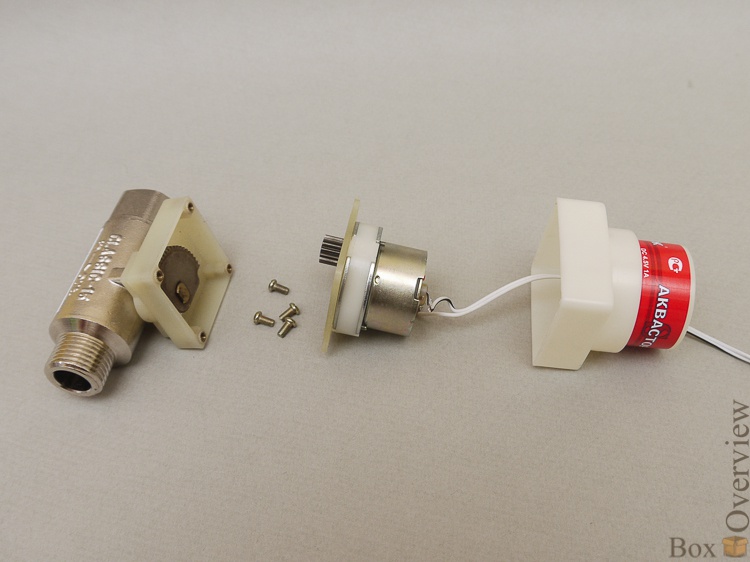
From the side of the crane:
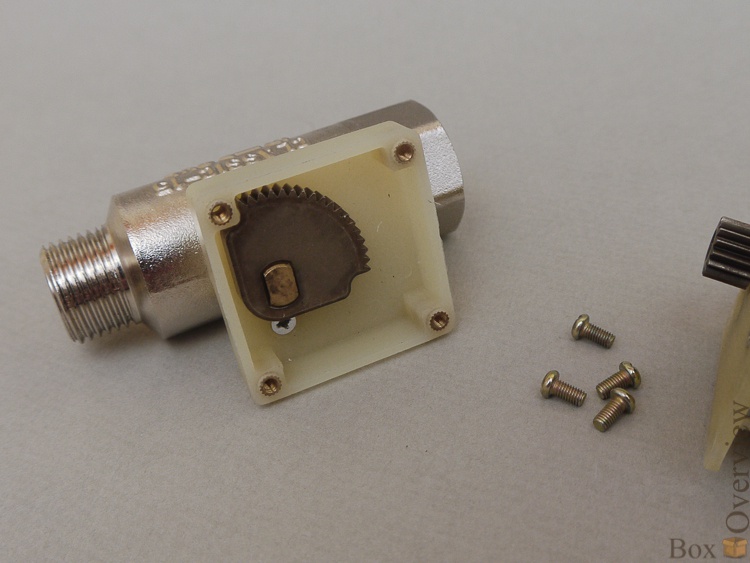
Serious metal gear that closes the ball valve. In the first versions, it was plastic, but they corrected this flaw. From the side of the engine:
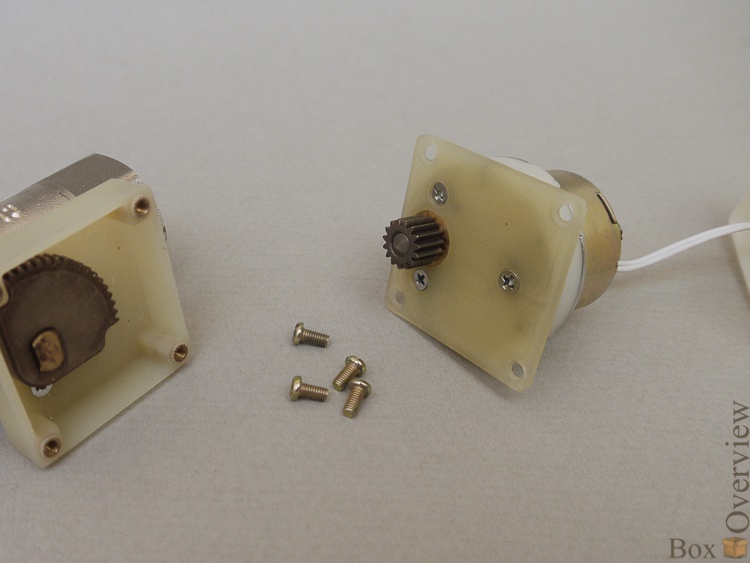
Also the metal gear of the output shaft of the gearbox (a device that reduces the speed of rotation and increases the force). Everything looks serious. Cranes, by the way, are also special - with low friction, to facilitate the rotation of the crane by a small engine. It closes really easily - you can turn your finger without straining it. Other systems have cranes with an engine that is powered by 220v, but there is another problem - safety and the inability to turn off the tap when the electricity is turned off. And according to the law of Murphy, electricity is cut down at the most inopportune moment. So I'd rather redeem a little for a low-voltage engine tap.
')
Sensor
The wired flood sensor (TK24) is as simple as two kopecks:
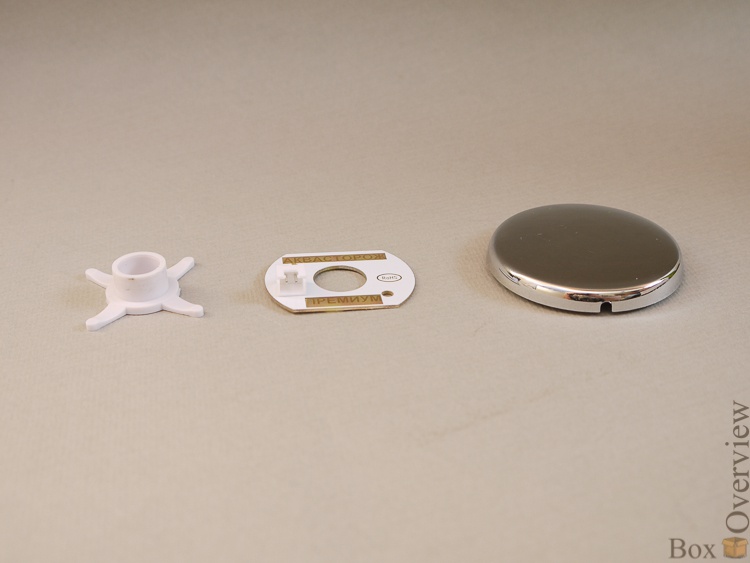
The wire, housing, and fiberglass plate with two contacts. The contacts get wet - the resistance decreases, the controller understands it and blocks the water. There is nothing to break here - contacts are covered with immersion gold, which means they will not oxidize and will not rot.
Contact areas:

This sensor is "premium", and in simple words - with protection against wire break. The problem is that for the controller, the “normal” sensor that failed, and the sensor for which the wire was broken, is the same. The protection against this is a simple capacitor:
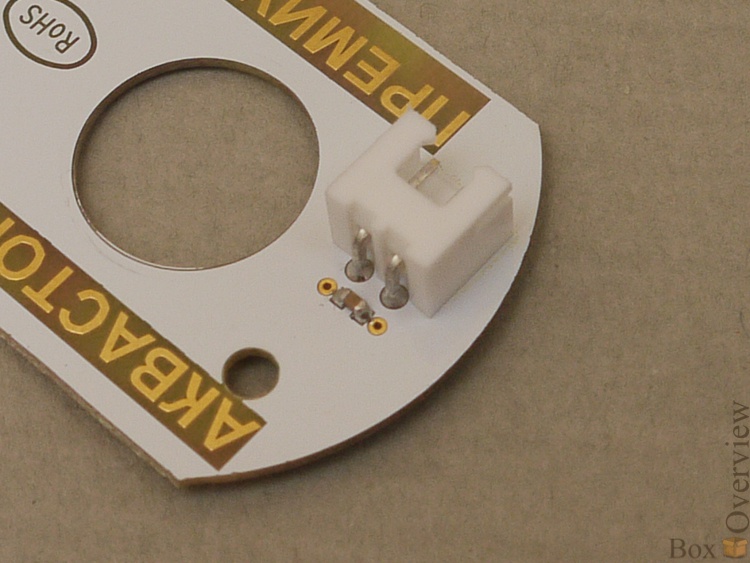
It conducts alternating current, and by its presence the controller can detect already three states - short circuit (flood), no short circuit (sensor in place), and no contact (wire break).
The sensor is very simple, and if you have direct hands, you can make as many as you like for your needs - even LUT-ohm from PCB, even from two strips of a can and wire. Just take care of splash protection - otherwise one day during a shower you will have to crawl out of the bath and explain to the controller that this is not a flood, but just drops dropped :) But this is me about the self-made sensor - the “branded” case design provides protection from accidental splashes . In addition, they will only work if the water level reaches 1 mm in the entire sensor area - this is about 10-15 ml of water.
Radio base and sensors

An additional unit (TK17), which adds to the ordinary sensors also several wireless ones. There are two of them, but you can buy and add another 6 - they become attached to this block. And 12 more sensors are connected to the expansion unit (TK19). As a result, the total number of wireless sensors - 20 pieces. I do not know why so much, except for some big cottage.
The radio base board has its own personal ionistor in order not to waste the energy of the main board for the maintenance of the radio sensors.

The controller, and another squeaker:
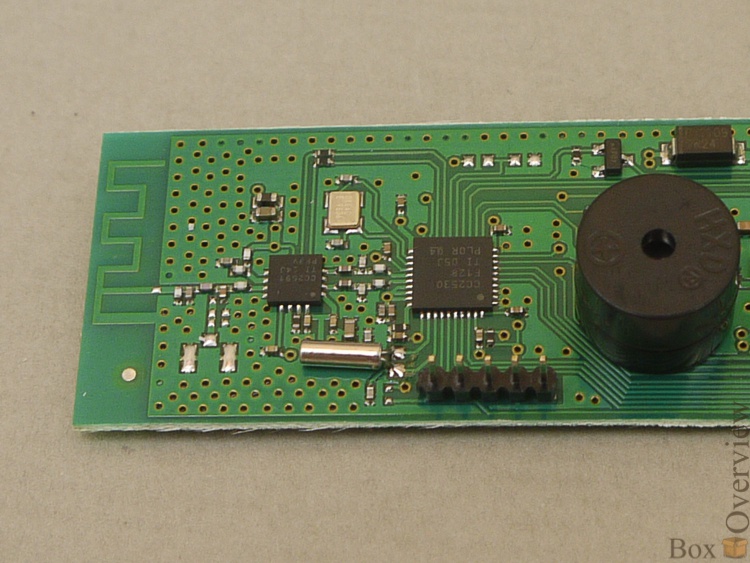
And here are the radio sensors:
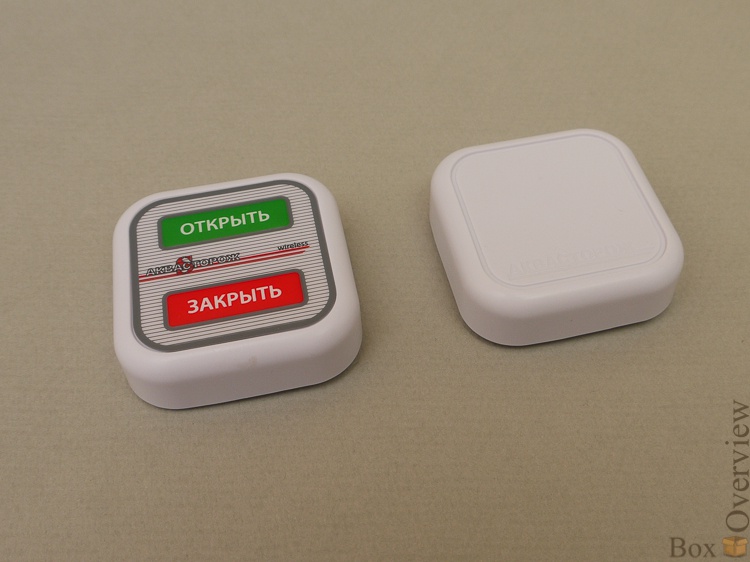
The right one is just a sensor (TK16), and the left one is the sensor-remote control (TK18). Buttons can be used to close and open taps at any time.
On the reverse side of both sensors there is a board already familiar to us with contacts:
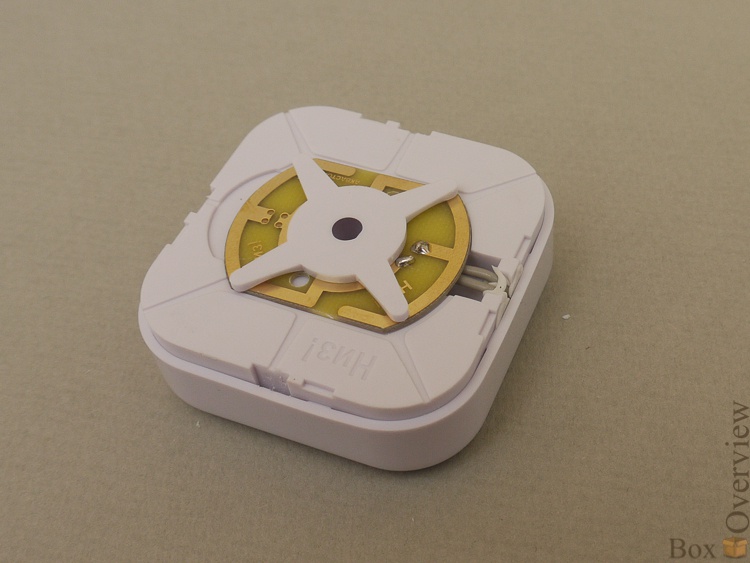
The sensor can be easily disassembled - it is necessary to pry the central part in turn from all sides with a flat screwdriver. It holds very firmly - as I understand it, it is made from the penetration of water.
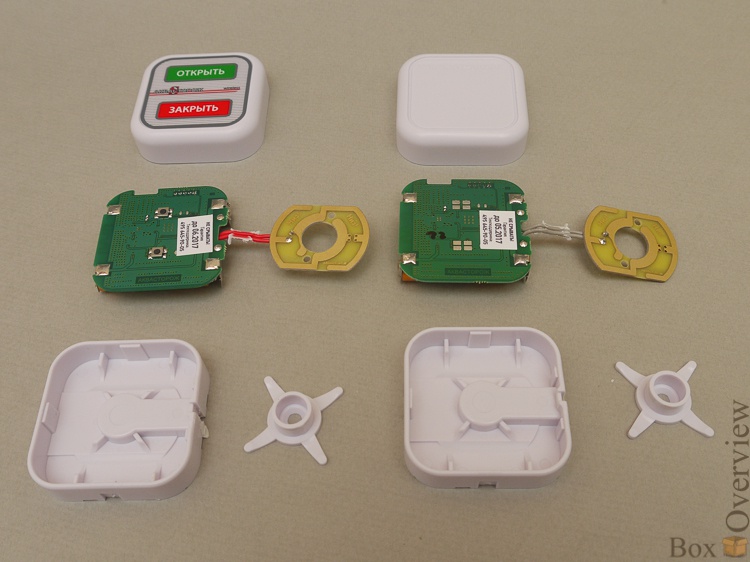
By the way, a sensor with a button is the same as a sensor without a button, only with a button:
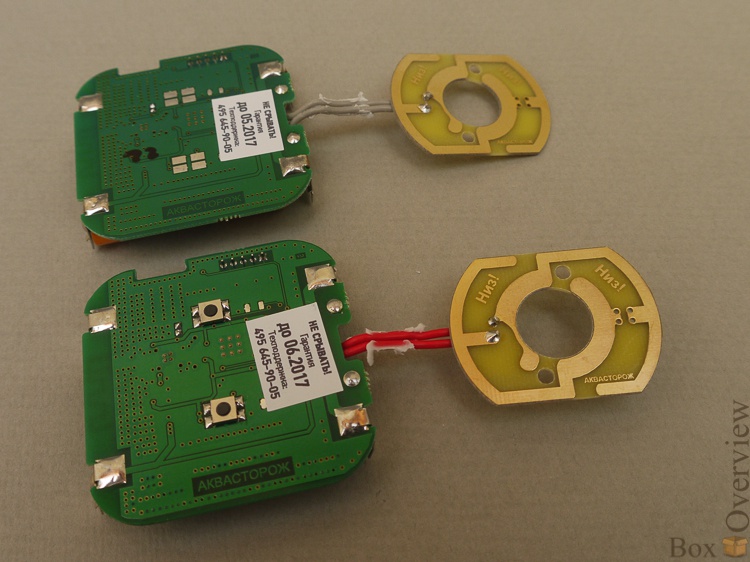
So if your hands itch and the soldering iron heats up, the button can be attached - I checked that the contacts are working.
On the reverse side of the board are contacts for batteries (2xAAA):
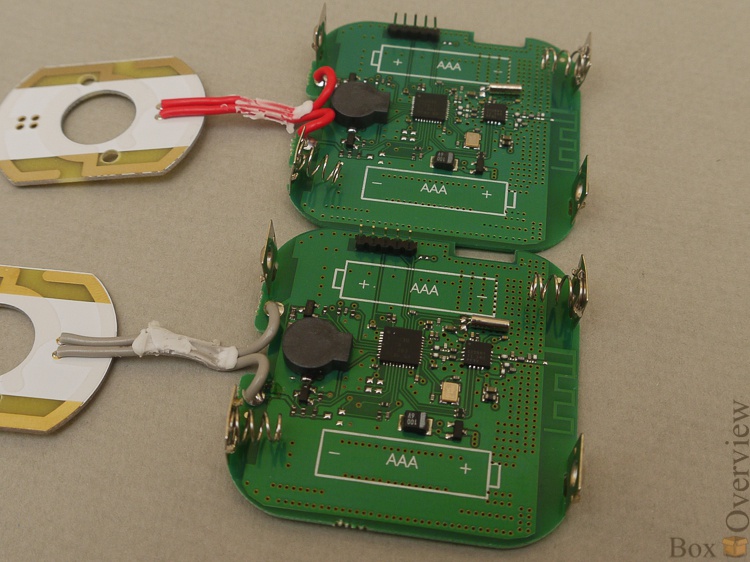
Controller, strapping and squeaker:
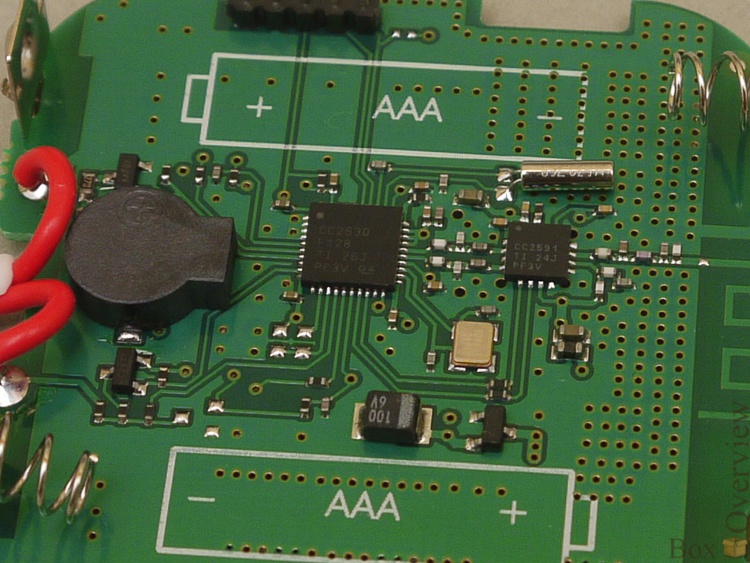
Assembly
We begin to build the system under our requirements. Add a second battery pack:

Just insert the wires into the empty jack socket:

And we connect two blocks together:
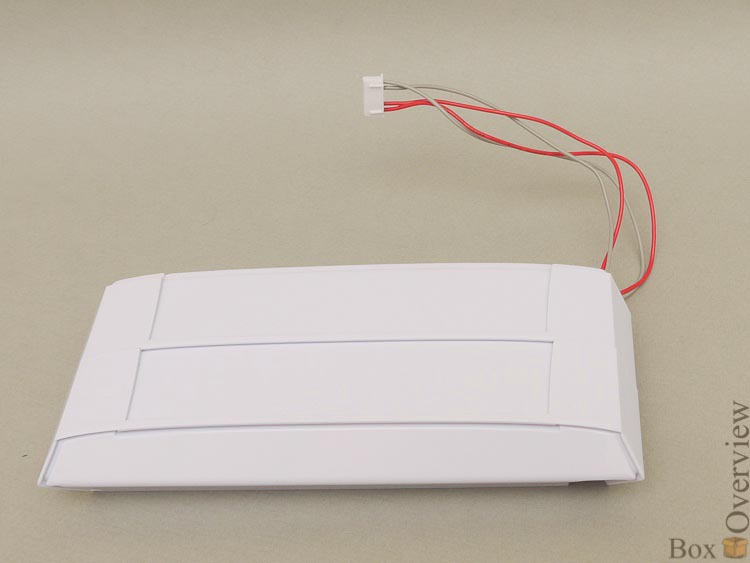
We take the radio base:

Turning off the additional sensor unit and connect the radio base:
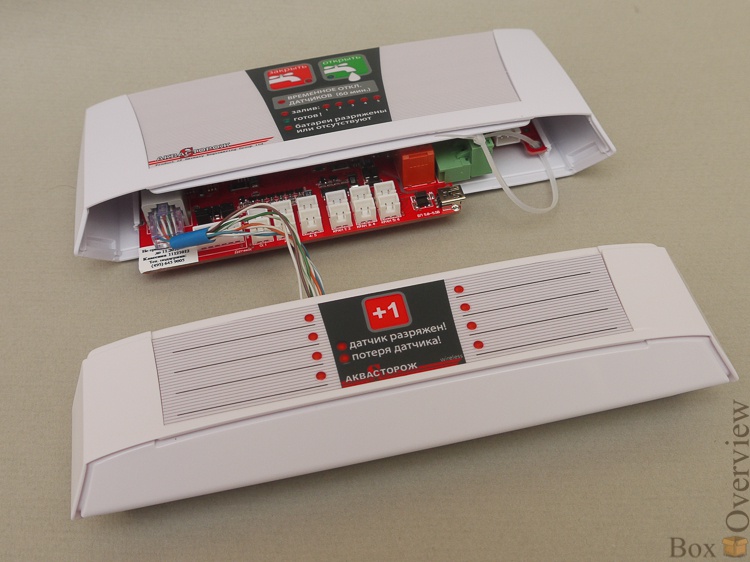
Connect the battery packs:

And put it all together:
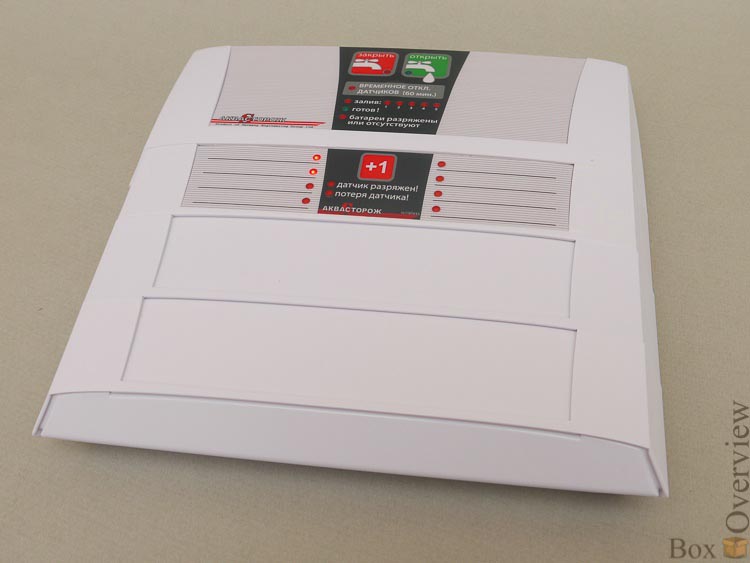
Constructor. We, by the way, forgot to connect the taps and the wired sensor. And external power, if necessary - when using it does not waste battery power, and wireless sensors are polled constantly. When using battery power, the response to pressing a button on a wireless sensor or flooding it should be with a slight delay - from 1 second to 5.
Installation
First, we do the simplest thing: fasten the mounting socket with two screws:
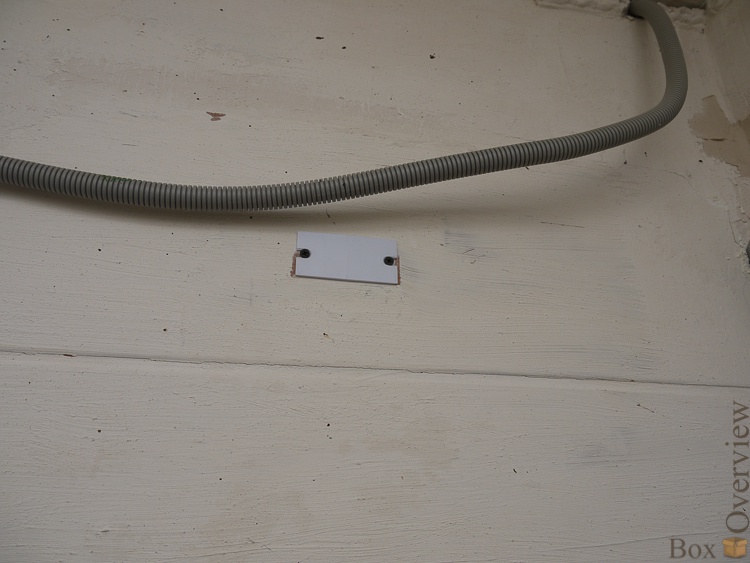
And we hang the controller on it:
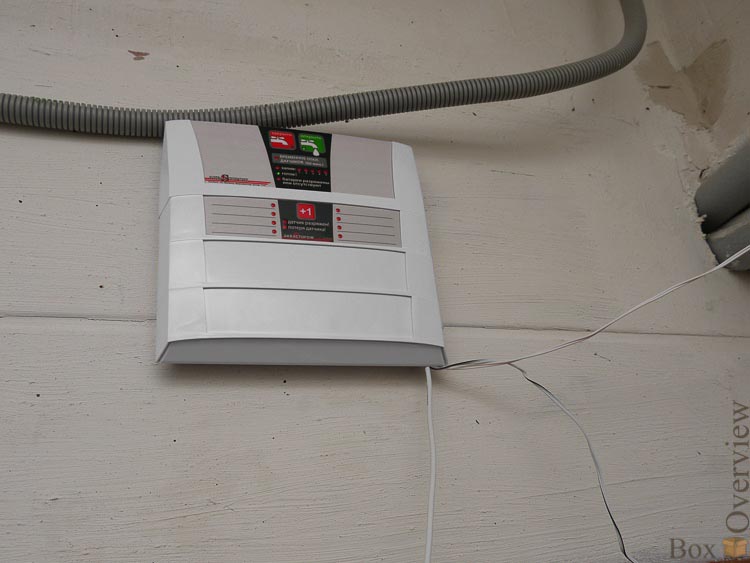
We assorted cranes:
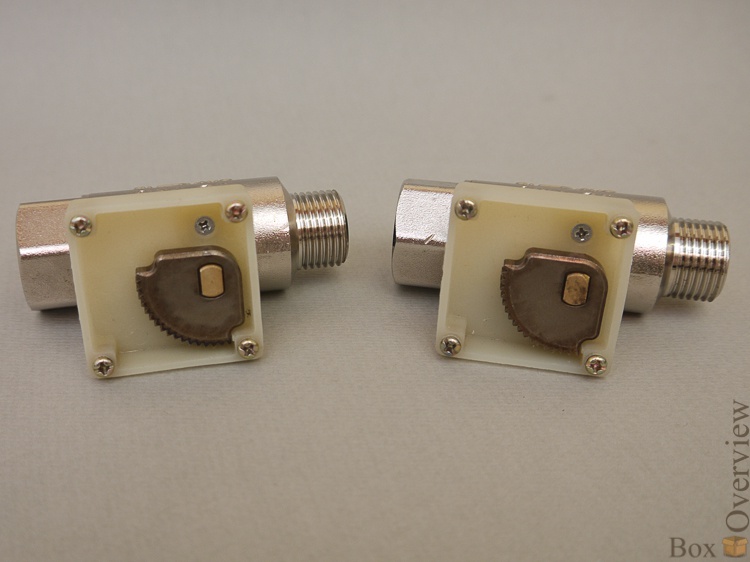
I did this for ease of installation on an already finished system, because the engine was too protruding - it was not very convenient to mount.
We wind the thread of the valve with fumlenta:

Shut off the water, and think where to insert the faucet, so much so as not to call the plumber to reassemble the entire system?
I have some free space after the counter - where there is a check valve. Look at the bottom pipe (I did not remove the process of installing the tap on hot water):
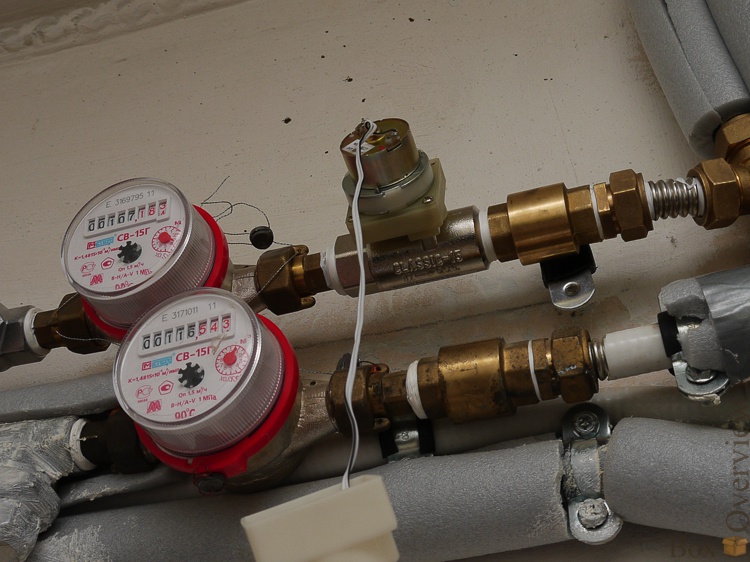
Turn off what you have unscrewed. We see the free thread - wrapped with fumlenta :)

Screw the valve on the crane:

And we wind all this design back on the counter.
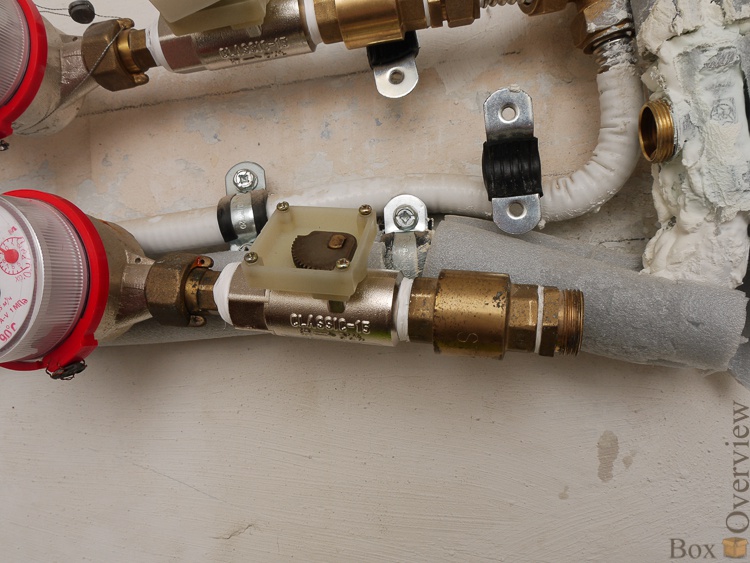
Cut the connecting pipe - the crane took its place, do not carry all the other pipes for this?
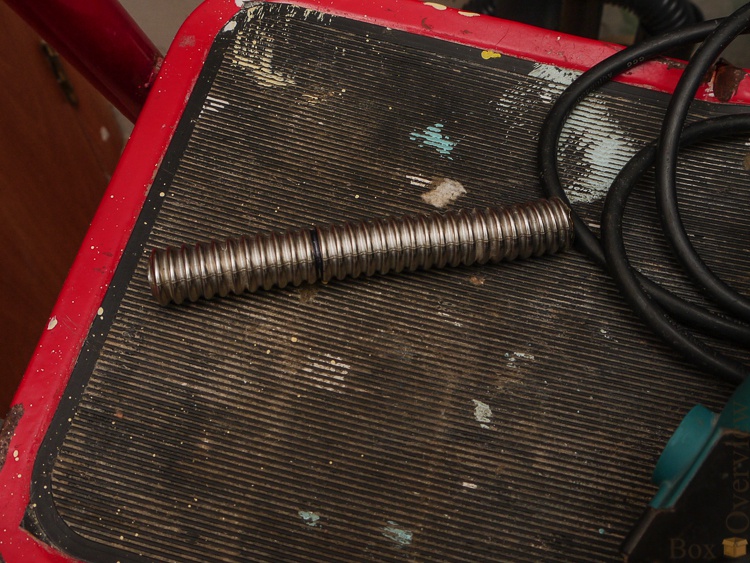
And set in place:

We screw the engine into place and put the wires in order:
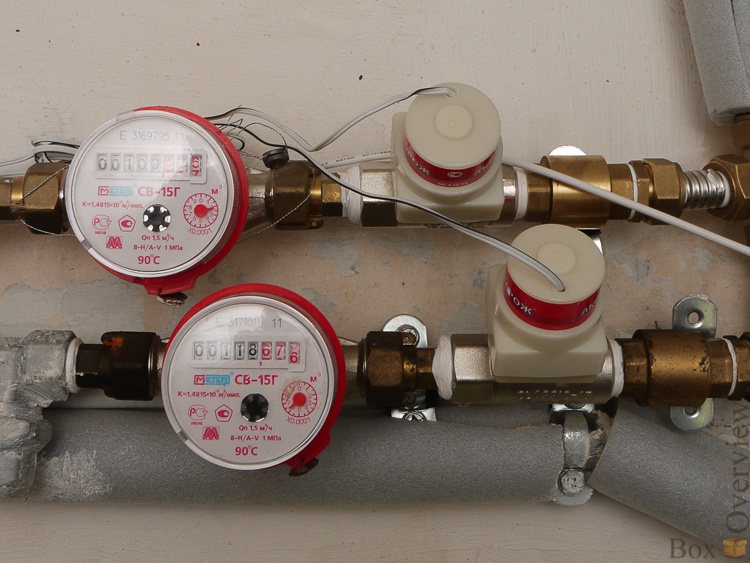
Radio sensors simply put in places of possible flooding:

We remove the wire through a hole in the wall (it took to cut the wire, and then connect it with scotch-locks ):

Pull the wire down:

Screw the pad to the floor, install the sensor itself:

And close the lid:
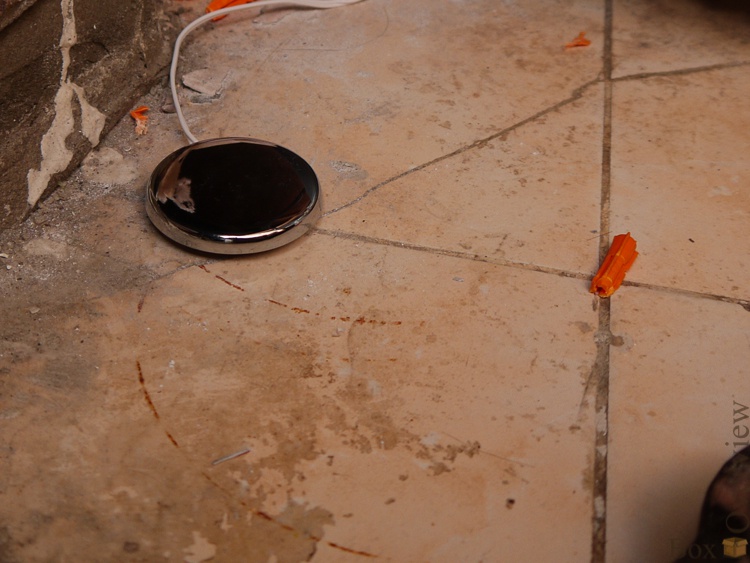
Sensors are located in the apartment like this:

One - under the sink, the other - under the washing machine. Wired sensor - under the bathroom. The plan was drawn in SweetHome 3D
Connect the wires to the controller:
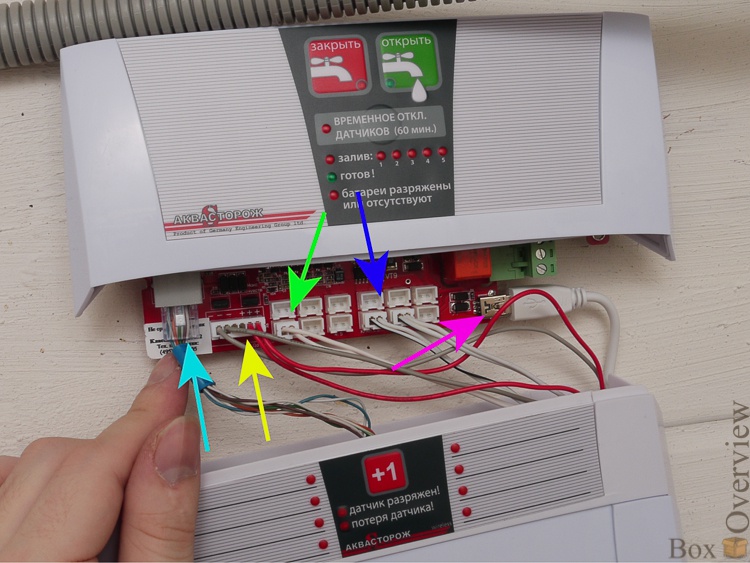
Green - sensor. In the first connector (it is signed as zero) - only the sensor (or a chain of sensors) is switched on without monitoring the wire breakage. In the remaining connectors - sensors with control of open circuit.
The blue arrow connectors are taps. There is no difference, they all close and open the same way. Lilac and yellow - external and battery power respectively. Blue - connector expansion cards (we have a radio base connected to it).
In general, the system after installation looks like this:

It remains only to brush the wires so that they do not hang over your head.
Check
I did not break the pipe, but I had to figure out a small deluge in the bathroom:
The price depends on the kit, for example the cheapest (TH00) will cost you 6,220 rubles. It includes two wired sensors and one tap. The additional crane (TK12) is another 2 390 rubles. Thus, the most budget solution for an apartment with hot and cold water is 8,610 rubles.
That version of the system that I had would cost 15,990 rubles. It includes two cranes, and four sensors - two wired and two radios.
Links
 Review from AlexeyNadezhin
Review from AlexeyNadezhin
 Official site
Official site
 Offsite mirror
Offsite mirror
 System suppliers in Belarus
System suppliers in Belarus
 Overview of the old version of the system from DataLab
Overview of the old version of the system from DataLab
 IXBT Talk
IXBT Talk
If you do not have an account on Habrahabr, you can read and comment on our articles on BoxOverview.com

Aquastoroz is a system that automatically shuts off water when flooding is detected. A pipe burst through - water gushes on the floor, hits the sensor, and the servo closes the taps on the risers. Of course, it will not save you from wet floors - some of the water will still be on the floor, but the repair will protect, and at the same time protect you from compensation after the flooding of your neighbors below. Let's see, we will disassemble the Aquastoroz system into parts and find out if it is so good?
Controller
The whole set is in this box:
The front shows the kit, and on the side, the principle of the system:

There is also a good and clearly written user manual:

The main part of the system looks like this:

Two taps - for cold and hot water, the main control unit, bay sensors, an external power supply.
Here is the main unit (TK03) closer:

The controller is made very interesting - it is going as a constructor into which additional blocks of extensions are inserted. Not enough 6 wired sensors? Add a panel, we get 18 sensors. We want to make a wireless system out of a normal system? Insert the radio base and connect it to a special plug. Need the ability to turn off the heat or the pump when the water is turned off? We connect the panel with power relyushki. Not enough standard battery pack? We insert one more, extend the autonomous operation of the system for another year (if there are only wired sensors in the system, then for three years).
The entire system, except for wired sensors, is valid for 4 years. On the sensors lifetime warranty. True, they promise a free replacement of no more than 3 sensors per user, apparently guided by the consideration “if a person breaks 3 sensors in a row, then the problem is not with the sensors”.
In my version of the sensors, four - two wired, and two radio sensors. The system can simultaneously work with those and with others. The maximum number of wireless sensors is 8 (2 included), or 20 with an expander panel (TK19). The number of wired sensors is almost unlimited - in each connector you can connect a chain of up to 100 pieces, in total - as many as 600 pieces.
The site has a page on which all possible components with articles are described - in the future I will quote them in brackets for convenience.
Very interesting solution. Here is the mechanism for connecting the blocks, on one side of the latch:

On the other - a place for wires that connect the blocks to each other:

We understand. Although disassembly is difficult to call - just pull the board out of the slots:

Controller, beeper (very loud and nasty):

Two ionistors on 20F:

And one on 10:

These are the same Nano-UPS :)

But as a matter of fact, it is correct - they store a store of energy, which is enough for the device to work and the cranes to shut off after the batteries have completely sat down. In general, if an accident occurs, the system will work and shut off the water even when batteries are dead. After that, you can still once open the taps with a button, if you urgently need water, and there is no time to run after the batteries - this moment is thought out, which is nice. But after that, the battery will have to be replaced.
Below on the board are 14 connectors, one of which is for the battery pack, one for connecting blocks, 6 for wired sensors, and 6 for taps. As I already wrote - wired sensors can be almost unlimited number - they can be connected in parallel with each other. However, when using a sensor with a break control, it must be the last in the chain - otherwise the controller will not notice a break after it.
Cranes
Here are two cranes (TK12):
On each - a strict piece of paper :)

We disassemble the crane into two parts:

From the side of the crane:

Serious metal gear that closes the ball valve. In the first versions, it was plastic, but they corrected this flaw. From the side of the engine:

Also the metal gear of the output shaft of the gearbox (a device that reduces the speed of rotation and increases the force). Everything looks serious. Cranes, by the way, are also special - with low friction, to facilitate the rotation of the crane by a small engine. It closes really easily - you can turn your finger without straining it. Other systems have cranes with an engine that is powered by 220v, but there is another problem - safety and the inability to turn off the tap when the electricity is turned off. And according to the law of Murphy, electricity is cut down at the most inopportune moment. So I'd rather redeem a little for a low-voltage engine tap.
')
Sensor
The wired flood sensor (TK24) is as simple as two kopecks:
The wire, housing, and fiberglass plate with two contacts. The contacts get wet - the resistance decreases, the controller understands it and blocks the water. There is nothing to break here - contacts are covered with immersion gold, which means they will not oxidize and will not rot.
Contact areas:

This sensor is "premium", and in simple words - with protection against wire break. The problem is that for the controller, the “normal” sensor that failed, and the sensor for which the wire was broken, is the same. The protection against this is a simple capacitor:

It conducts alternating current, and by its presence the controller can detect already three states - short circuit (flood), no short circuit (sensor in place), and no contact (wire break).
The sensor is very simple, and if you have direct hands, you can make as many as you like for your needs - even LUT-ohm from PCB, even from two strips of a can and wire. Just take care of splash protection - otherwise one day during a shower you will have to crawl out of the bath and explain to the controller that this is not a flood, but just drops dropped :) But this is me about the self-made sensor - the “branded” case design provides protection from accidental splashes . In addition, they will only work if the water level reaches 1 mm in the entire sensor area - this is about 10-15 ml of water.
Radio base and sensors

An additional unit (TK17), which adds to the ordinary sensors also several wireless ones. There are two of them, but you can buy and add another 6 - they become attached to this block. And 12 more sensors are connected to the expansion unit (TK19). As a result, the total number of wireless sensors - 20 pieces. I do not know why so much, except for some big cottage.
The radio base board has its own personal ionistor in order not to waste the energy of the main board for the maintenance of the radio sensors.

The controller, and another squeaker:

And here are the radio sensors:

The right one is just a sensor (TK16), and the left one is the sensor-remote control (TK18). Buttons can be used to close and open taps at any time.
On the reverse side of both sensors there is a board already familiar to us with contacts:

The sensor can be easily disassembled - it is necessary to pry the central part in turn from all sides with a flat screwdriver. It holds very firmly - as I understand it, it is made from the penetration of water.

By the way, a sensor with a button is the same as a sensor without a button, only with a button:

So if your hands itch and the soldering iron heats up, the button can be attached - I checked that the contacts are working.
On the reverse side of the board are contacts for batteries (2xAAA):

Controller, strapping and squeaker:

Assembly
We begin to build the system under our requirements. Add a second battery pack:
Just insert the wires into the empty jack socket:

And we connect two blocks together:

We take the radio base:

Turning off the additional sensor unit and connect the radio base:

Connect the battery packs:

And put it all together:

Constructor. We, by the way, forgot to connect the taps and the wired sensor. And external power, if necessary - when using it does not waste battery power, and wireless sensors are polled constantly. When using battery power, the response to pressing a button on a wireless sensor or flooding it should be with a slight delay - from 1 second to 5.
Installation
First, we do the simplest thing: fasten the mounting socket with two screws:
And we hang the controller on it:

We assorted cranes:

I did this for ease of installation on an already finished system, because the engine was too protruding - it was not very convenient to mount.
We wind the thread of the valve with fumlenta:

Shut off the water, and think where to insert the faucet, so much so as not to call the plumber to reassemble the entire system?
I have some free space after the counter - where there is a check valve. Look at the bottom pipe (I did not remove the process of installing the tap on hot water):

Turn off what you have unscrewed. We see the free thread - wrapped with fumlenta :)

Screw the valve on the crane:

And we wind all this design back on the counter.

Cut the connecting pipe - the crane took its place, do not carry all the other pipes for this?

And set in place:

We screw the engine into place and put the wires in order:

Radio sensors simply put in places of possible flooding:

We remove the wire through a hole in the wall (it took to cut the wire, and then connect it with scotch-locks ):

Pull the wire down:

Screw the pad to the floor, install the sensor itself:

And close the lid:

Sensors are located in the apartment like this:

One - under the sink, the other - under the washing machine. Wired sensor - under the bathroom. The plan was drawn in SweetHome 3D
Connect the wires to the controller:

Green - sensor. In the first connector (it is signed as zero) - only the sensor (or a chain of sensors) is switched on without monitoring the wire breakage. In the remaining connectors - sensors with control of open circuit.
The blue arrow connectors are taps. There is no difference, they all close and open the same way. Lilac and yellow - external and battery power respectively. Blue - connector expansion cards (we have a radio base connected to it).
In general, the system after installation looks like this:

It remains only to brush the wires so that they do not hang over your head.
Check
I did not break the pipe, but I had to figure out a small deluge in the bathroom:Price
You can buy the system on the official website .The price depends on the kit, for example the cheapest (TH00) will cost you 6,220 rubles. It includes two wired sensors and one tap. The additional crane (TK12) is another 2 390 rubles. Thus, the most budget solution for an apartment with hot and cold water is 8,610 rubles.
That version of the system that I had would cost 15,990 rubles. It includes two cranes, and four sensors - two wired and two radios.
Links
 Review from AlexeyNadezhin
Review from AlexeyNadezhin Official site
Official site Offsite mirror
Offsite mirror System suppliers in Belarus
System suppliers in Belarus Overview of the old version of the system from DataLab
Overview of the old version of the system from DataLab IXBT Talk
IXBT TalkIf you do not have an account on Habrahabr, you can read and comment on our articles on BoxOverview.com
Source: https://habr.com/ru/post/173007/
All Articles